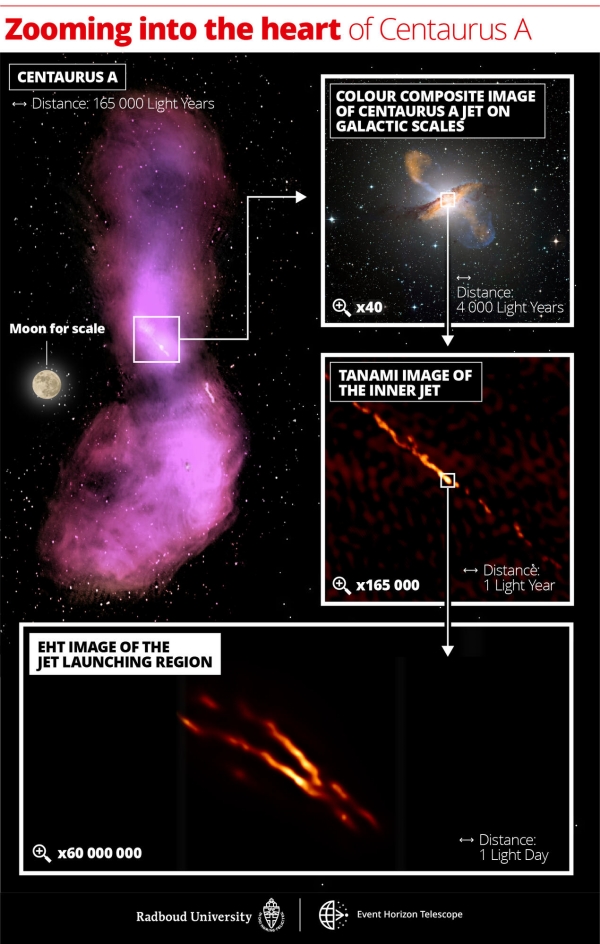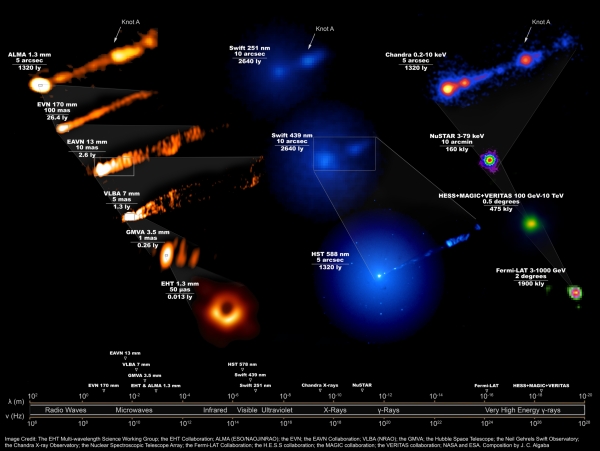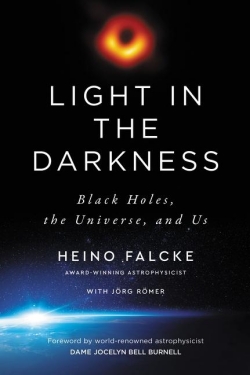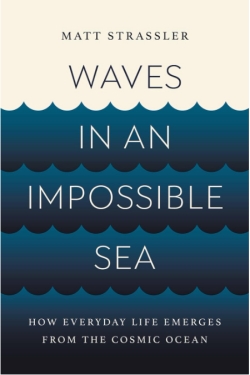The X-ray ‘echoes’ from the Seyfert galaxy I Zwicky 1 occupied us on Friday, but today I want to explore the larger content of black hole research following the news about the relatively nearby active galaxy called Centaurus A. Whereas the X-ray work took data from two X-ray telescopes, NuSTAR and XMM-Newton, the Centaurus A investigation gives us another startling image from the instrument that to my mind has the coolest name of them all when it comes to observing tools — the Event Horizon Telescope.
It was the virtual EHT, of course, that produced the first image of a black hole, the supermassive object at the center of M87. The same observing campaign in 2017 produced the data used in the new paper on Centaurus A. At some 10-13 million light years, Centaurus A is — at radio wavelengths — one of the largest and brightest objects in the sky. Its central black hole is thought to mass about 55 million suns. By contrast, the EHT researchers have estimated the black hole in M87’s center to be 6.5 billion times more massive than the Sun, while our own Sgr A* — the Milky Way’s supermassive black hole — is thought to mass on the order of a ‘mere’ 4.3 million solar masses.
The Centaurus A study, led by Michael Janssen (Max Planck Institute for Radio Astronomy and Radboud University, Nijmegen) presents intriguing data on the galaxy’s enormous jet, as shown in the image below. Notice the range of observatories involved in this work, as listed in the caption. The Event Horizon Telescope data is here being supplemented by ground-based and space-based equipment, reminding us of the essential collaborative nature of the experiment when trying to mount a global interferometric effort and tease the greatest amount of information out of the result.

Image: Distance scales uncovered in the Centaurus A jet. The top left image shows how the jet disperses into gas clouds that emit radio waves, captured by the ATCA and Parkes observatories. The top right panel displays a color composite image, with a 40x zoom compared to the first panel to match the size of the galaxy itself. Submillimeter emission from the jet and dust in the galaxy measured by the LABOCA/APEX instrument is shown in orange. X-ray emission from the jet measured by the Chandra spacecraft is shown in blue. Visible white light from the stars in the galaxy has been captured by the MPG/ESO 2.2-metre telescope. The next panel below shows a 165,000x zoom image of the inner radio jet obtained with the TANAMI telescopes. The bottom panel depicts the new highest resolution image of the jet launching region obtained with the EHT at millimeter wavelengths with a 60,000,000x zoom in telescope resolution. Indicated scale bars are shown in light years and light days. Credit: Radboud Univ. Nijmegen; CSIRO/ATNF/I. Feain et al., R. Morganti et al., N. Junkes et al.; ESO/WFI; MPIfR/ESO/APEX/A. Weiß et al.; NASA/CXC/CfA/R. Kraft et al.; TANAMI/C. Müller et al.; EHT/M. Janßen et al.
Supermassive black holes cause the release of vast amounts of energy as some of the gas and dust near the accretion disk is blown into space in the form of jets. There is plenty to work with in the EHT data, and new questions raised, for only the outer edges of the jet appear to emit radiation, another reminder of how much we have to learn about the processes in play in this phenomenon. But let’s home in for now on the quality of the imagery.
For compared to previous work, we see the jet at Centaurus A at 16 times sharper resolution than ever before. The magnification factor here is one billion. EHT astronomers believe they can locate the black hole itself at the launching point of the jet, a location that will be explored in future observations at shorter wavelength and still higher resolution that will incorporate the use of space-based observatories.
The technique at Centaurus A, as it was at M87, was Very Long Baseline Interferometry (VLBI). If black hole jets occur at the stupendous scale we see here, it’s fitting that a planet-sized aperture would be used to see one of them up close. The Event Horizon Telescope originally joined eight telescopes around the globe to create this virtual capability, with other radio dishes around the globe later coming into play as observations continued. More than 300 researchers are involved in the effort worldwide.
We have to go back to 1971 to find the roots of the Event Horizon Telescope, as Heino Falcke points out in his book Light in the Darkness (HarperOne, 2021). This was when Donald Lynden-Bell and Martin Rees predicted that VLBI techniques on the scale of a continent could be used to discover a compact radio source like a black hole at the center of our own galaxy. Seyfert galaxies, bright with radio plasma, were suspected of hosting central black holes, part of a grouping of galaxies known to possess active galactic nuclei (AGN). It made sense that the Milky Way might have its own black hole. Three years later a compact radio source was discovered there.
Thus we learned about Sagittarius A*, a fascinating find but one whose image from Earth was compromised by the dust and hot gas along the galactic disk. The move toward shorter wavelength observation to study an object that was dark at almost every wavelength except that of radio frequency light makes for fascinating reading in Falcke’s book. Puzzles abounded. If Sagittarius A* were a black hole, it seemed a weak one. Quasar 3C 273, if placed in the Milky Way, would be 40 million times brighter.
Falcke wrote his doctoral thesis around the question of what he describes in his book as ‘starved black holes.’ If Sagittarius A* is no more than a weak glimmer compared to some, it implied that the black hole was simply not drawing in the matter needed to produce a stronger signature. If the average quasar consumed one sun per year, his calculations showed that our black hole must suck in ten million times less mass. That’s the equivalent of about three moons per year. From the book:
…contrary to popular belief, black holes generally aren’t wildly voracious monsters: they’re very well behaved and eat only what they’re served. In our imagination, black holes might be giant, but compared to an entire galaxy they’re just little chicks. And like chicks in the nest, black holes must wait for food, must wait for their mother galaxy to feed them with dust and stars. If this doesn’t happen, they waste away, go dark and quiet, and stop growing — just like Sagittarius A*. But they don’t die.
How to build a globe-spanning interferometric network to study Sagittarius A*, or the huge M87* source at the center of that galaxy? With eight observatories around the planet, the radio signals have to be perfectly synchronized to allow the observation, the position of the observatories known to the millimeter and the arrival time of signals received measured with atomic clocks of picosecond precision. As Falcke points out, such a radio telescope is assembled on a computer. Algorithms build the image.
And money builds the interferometer or, at least, the effort needed to coordinate a planet-sized effort like the EHT, and as countless meetings and strategy planning both online and in person continued and proposals were generated — we are talking a process years in the making, of course — M87 began to emerge as a viable target for the first attempt at an image of a black hole. Its black hole is two thousand times farther away — 55 million light years out — but it’s also huge, and estimates of its size had continued to grow as work on the EHT concept continued.
The advantages were many: M87 was easier to see from the northern hemisphere, where most of the EHT’s telescopes were located. It was also not located along the line of sight of the Milky Way’s disk, making it a clearer target. It’s no surprise that, among the EHT’s sources, including Sgr A*, M87 should have become the one whose results were most anticipated.
Falcke brings to the evolution of the EHT the same intensity that Alan Stern brought to the scientific, political and financial effort to build New Horizons in his book Chasing New Horizons (Picador, 2018). His eye for detail makes the observing sites lively places indeed, while he clarifies the technical issues without jargon. This is a project collecting data at 32 gigabits per second, all recorded on hard drives for future processing. As Falcke puts it:
Only after a lengthy process does a tiny image emerge from the giant quantity of data — talk about data reduction! Really we’re only recording static: static from the sky, receiver static, and a small bit of static from the edge of the black hole. Thankfully a large part of the sky and receiver static can be filtered out when the data are processed afterward. The total energy of the static that such a telescope gathers from our cosmic radio source in one night is incomprehensibly small. It’s the equivalent of the energy produced by a strand of hair one millimeter long that falls from a height of half a millimeter in vacuum onto a glass plate. The impact will hardly scratch the glass, but we can measure it.
We know the outcome, but that doesn’t lessen the drama. In April of 2017, the eight EHT observatories — two in Chile, two in Hawaii, one in Spain, one in Mexico, another in Arizona and a last one at the south pole — all pointed at the target in M87. Falcke heads for Málaga, test runs begin via the global network, the observations kick in. There is no way for all eight of the telescopes to measure simultaneously because of differences in location. The work has to be staggered, the data then synchronized. Calibration tests on quasars are conducted, then the first observations of M87 begin. At Málaga:
The telescope turns slowly toward the Virgo constellation, the second largest in the sky. We follow the motion on the display, transfixed. The telescope positions itself to find the right azimuth, or angle along the horizon; its elevation, or vertical angle, is perfect now as well. Same as with any other large movement, we have to do a little adjusting afterward. “Pico Veleta on source M87 and recording, pointing on nearby [quasar] 3C 273,” Krickbaum reports. The plots in the control room show plausible signal levels; the hard drives spin and fill up. A reassuring sign. On our instruments we see how the telescope follows the center of M87, moving counter to the Earth’s rotation. For hours now we swivel back and forth between M87 and a calibration quasar for scans of a few minutes each. Now everything seems to take care of itself.
As morning comes in Spain, the telescopes in Hawaii go into action observing M87, for a time simultaneously with Málaga before Spain shuts down. This is a distance of 10,907 kilometers, Falcke points out, the longest distance in the network. Arizona and Hawaii keep recording data for hours more. And this is only round one. The weather intervenes, then moderates. The words ‘go for VLBI’ take on an urgency like a rocket liftoff.
Consider that to make the Event Horizon Telescope work, you have to coordinate the position of each telescope relative to the sky as well as the time of arrival of the emissions being observed, which means modeling the motion of the Earth, taking into account pole-wandering due to the motion of its oceans and the effects of its atmosphere. Then a supercomputer goes to work looking for common oscillations. This means figuring out correlations between the received data to make sure they depict the same thing.
As Falcke points out, being a millisecond off in your timing means searching through millions of alternatives, which is why the analysis of the EHT’s data takes far longer than making the observations. Using quasars for calibration and testing is critical. It turned out to take nine months just to correlate the observations that produced the famous image of M87’s black hole. Or I should say, its ‘shadow,’ for no light can escape the black hole itself. The imaging teams had to wrestle with the fact that there are numerous ways of turning these data into a final image. We wind up with an image with the resolution that would be produced with an aperture the size of the Earth despite technical glitches, variable weather, and the need to schedule observing times at all the observatories, no mean feat in itself.

Image: Composite image showing how the M87 system looked, across the entire electromagnetic spectrum, during the Event Horizon Telescope’s April 2017 campaign to take the iconic first image of a black hole. Requiring 19 different facilities on the Earth and in space, this image reveals the enormous scales spanned by the black hole and its forward-pointing jet, launched just outside the event horizon and spanning the entire galaxy. Credit: the EHT Multi-Wavelength Science Working Group; the EHT Collaboration; ALMA (ESO/NAOJ/NRAO); the EVN; the EAVN Collaboration; VLBA (NRAO); the GMVA; the Hubble Space Telescope, the Neil Gehrels Swift Observatory; the Chandra X-ray Observatory; the Nuclear Spectroscopic Telescope Array; the Fermi-LAT Collaboration; the H.E.S.S. collaboration; the MAGIC collaboration; the VERITAS collaboration; NASA and ESA. Composition by J.C. Algaba.
It’s impressive that so many of the simulations the EHT team ran match the image of M87 that emerged, and as Falcke notes, there is an exact correlation between the size of the object and its mass, with the ring of light brightest at the bottom, as gas rotating around the black hole near light speed moves towards us, becoming focused and intensified. 6.5 billion solar masses gives us a black hole with a diameter of about 100 billion kilometers, an event horizon with a circumference four times as large as the orbit of Neptune.
The fact that we can make such measurements and produce such images doing astronomy at planet-wide scale is a testament to the power of scientific collaboration and raw human persistence. The EHT is indeed cause for celebration, as the new paper on Centaurus A affirms.
The paper on Centaurus A is Janssen et al., “Event Horizon Telescope observations of the jet launching and collimation zone in Centaurus A,” Nature Astronomy 19 July 2021 (abstract / full text).




That would be a neat trick. Continental drift is about 2-3 mm/month, and the Earth is constantly flexing in response to the Moon’s gravity. Add in all the other events creating positional drift…
GPS is not accurate to the mm either.
I infer from later in the text that in fact the data from each telescope is stored, and then a massive computational effort is used to integrate the signals to arrive at a “best fit” for positioning and timing to overlay the signals so that they appear to come from a single telescope.
It is an operational tour de force.
A really lovely, insightful combination of original comment and peer review, Paul. I’m not clever enough to contribute to the science but I know good stuff when I see/read it!
Kind words much appreciated! Thank you, Andy. Glad to have you as a reader.
Line-of-sight calibration between observatories via (unmanned) stations in orbit (including on the moon) might reduce the need to take one’s “eyes” off the target to refer to quasars. Perhaps someday observatories co-orbital with the Earth would afford an aperture as wide as the Earth’s orbit.
The captions in the images and the text in the post are quite confusing. I think by “distance” they mean “scale” or “size”. Centaurus A is certainly not so close! It’s around 10-16 million light-years away.
Yes, good point, and I get the confusion. I just corrected the text to clarify.
This image pretty much sums up the scale that these celestial objects can grow to.
https://i.redd.it/elat2dlm45931.png
Quote by Paul Gilster: “6.5 billion solar masses gives us a black hole with a diameter of about 100 billion kilometers, an event horizon with a circumference four times as large as the orbit of Neptune.” Wow! That’s a large black hole.
Indeed. Extraordinary!
If I’m correctly relating the scale of those images with my sense of typical distances between galaxies — am I wrong to imagine that M87 could kinda sorta sterilize any neighbors, i.e., entire galaxies, that happen to drift into one of those jets?
Actually I meant Centaurus A.
It depends on how long the jet is but it is not very wide so it would not sterilize an entire galaxy, but only a planet that got in the path of the jet.